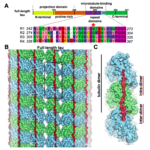Eva Nogales, faculty scientist in Molecular Biophysics & Integrated Bioimaging (MBIB) Division and UC Berkeley professor of molecular and cell biology, led a team that captured freeze-frames of the changing shape of a huge macromolecular complex as it locks onto DNA and loads the machinery for reading the genetic code. The molecule, called transcription factor IID (TFIID), is critical to transcribing genes into messenger RNA that will later be used as blueprints to make proteins.
Glaeser Honored with Glenn T. Seaborg Medal
Robert Glaeser, senior scientist in the Molecular Biophysics & Integrated Bioimaging Division, was awarded the Glenn T. Seaborg Medal by the Department of Chemistry & Biochemistry at the University of California, Los Angeles (UCLA). At a symposium held on November 1o, Glaeser and Richard Henderson, Nobel Laureate in Chemistry 2017, were recognized for their “crucial contributions to the science of electron cryo-microscopy.”
Photosynthesis, Like a Moss
Using cryo-electron microscopy (cryo-EM), which allows an unprecedented level of resolution, Biosciences researchers compared the structure of photosystem I in the moss Physcomitrella patens with its structure in the small flowering land plant Arabidopsis thaliana, and in the green alga Chlamydomonas reinhardtii. Because moss evolved after algae but before vascular land plants, such comparisons can shed light on how plants evolved to move from the ocean to land.
Biosciences’ Kenneth H. Downing Passes Away
The Berkeley Lab community mourns the loss of Kenneth H. Downing, who died August 2 at age 72. A senior scientist in the Molecular Biophysics and Integrated Bioimaging (MBIB) Division, Downing worked at the Lab for more than four decades. He passed away at home, surrounded by his family. A memorial service will be held on Saturday, September 1, at 11:00 a.m. at Lafayette Orinda Presbyterian Church, with a reception to follow.
Tau-tally Microtubular: A Structural Model of Tau-Microtubule Interaction
Researchers at Berkeley Lab and UC Berkeley have combined cutting-edge cryo-electron microscopy (cryo-EM) with computational molecular modeling to produce a near atomic-resolution model of the interaction between microtubules—crucial components of eukaryotic cell ultrastructure—and microtubule-associated proteins called tau. The model provides insight into how tau stabilizes microtubules, and what makes it dissociate to form tau aggregates, or “tangles,” in some neurological diseases—including Alzheimer’s disease—generally referred to as tauopathies.
Was this page useful?








